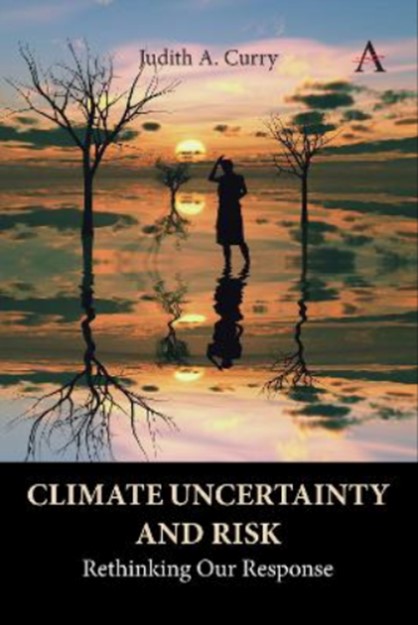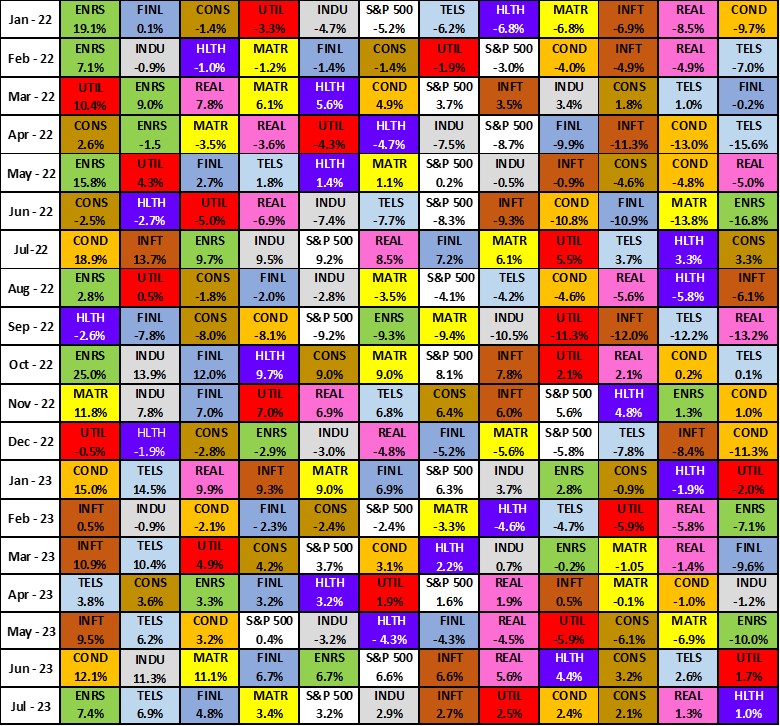Energy Musings contains articles and analyses dealing with important issues and developments within the energy industry, including historical perspective, with potentially significant implications for executives planning their companies’ future.
August 2, 2023
Climate Uncertainty And Risks Viewed By Judith Curry
Curry’s book is a tough read because it forces you to consider how much is unknown and uncertain about climate change science. A controversial climate scientist who was harassed and pressured to resign her tenured professorship and position as chair of the engineering school at Georgia Tech, Curry began to investigate why questioning the science was so unsettling. According to Curry, there are better ways to seek climate change solutions than our current fortress mentality approach. Read the book to understand this critical policy debate that is changing our economy and lives. READ MORE
Higher Oil Prices Drive Energy Stock Recovery
The S&P 500 Index sector report for July showed Energy was the top performer. After six months of poor performance in 2023, the rise in oil prices and improving economic outlooks boosting demand helped performance. Crude oil prices reached the highest level since April ($80 per barrel) and the monthly increase matched that of January 2022. Headwinds have become tailwinds and investors may be forced to reconsider their aversion to owning Energy stocks. READ MORE
Climate Uncertainty And Risks Viewed By Judith Curry
We just finished reading Judith Curry’s book, Climate Uncertainty And Risks: Rethinking Our Response, which provides a wonderful but challenging journey through the political minefield of climate change science and its policy prescriptions. For those of us who have been researching and writing about climate change – the science, data, and policy recommendations – we noted that the book’s title is suddenly out of date. U.N. Secretary-General António Guterres has just upped the climate rhetoric. The greenhouse effect of the 1980s was overtaken by global warming, which often was described as global heating. Then terminology shifts came quicker going from climate change to the climate crisis, the climate emergency, and now global boiling. What’s next – global vaporization?
Exhibit 1. Discovering What We Know And Do Not Know

Source: eBay
Curry’s new book was published in June. In January, Curry wrote on her blog about the book, its origin and objectives, the peer review process it was subjected to, and the book’s cost. The book was peer reviewed and issued by an academic publisher, Anthem, which wished to expand its ‘Environment and Sustainability Initiative’. Choosing this publisher made for a better volume in Curry’s view because of the peer review process, but it also created a cost problem for the book and its various formats. Imagine an author worried about how an expensive book might limit the reach and impact of her thinking!
She wound up with an academic publisher because she had become a lightning rod for the battles over climate change science that likely limited options. Curry’s academic credentials are solid – a cum laude Batchelor of Science degree from Northern Illinois University and a geophysical sciences Ph.D. from the University of Chicago. She also held faculty positions at Penn State University, Purdue, and the University of Wisconsin-Madison before moving to the School of Earth and Atmospheric Sciences at the Georgia Institute of Technology. She retired from her tenured professorship and as chair of the school in 2017 because of professional harassment.
Climate Uncertainty And Risks presents an extensive examination of the evolution of climate science, the roles of nature and human activity in generating CO2, and the weaknesses of climate models. The book studies how the unwillingness of climate scientists to address or even recognize the uncertainty of their research and climate models has led to the politicization of the debate over climate change science. The unwillingness of climate scientists to engage in open debate and scrutiny of the research pushed Curry into questioning the “experts.” The labeling of climate science questioners as “deniers” is an issue that has dogged Curry for nearly a quarter century. She wants climate scientists to be more honest and to educate the public about the known unknowns of climate change models and the resulting policy recommendations.
As a 2010 in-depth article about Curry in Scientific American states: “What she does believe is that the mainstream climate science community has moved beyond the ivory tower into a type of fortress mentality, in which insiders can do no wrong and outsiders are forbidden entry.” Curry’s book enables readers to understand how the fortress mentality developed and its dangers. She walks the reader through what climate change is and what we know about it with confidence. But we must also acknowledge which climate science issues have a low confidence level. Importantly, she explores the issue of consensus and the biases that creates it, as well as how challenging the consensus creates polarization.
The heart of the book is Curry’s exploration of the “Climate Change Uncertainty Monster.” This discussion leads to an examination of climate models and the Intergovernmental Panel on Climate Change scenarios. This examination sets the stage for the final half of the book, which is an in-depth discussion of risk, uncertainty, decision-making, mitigation, and adaptation – key issues for climate change policies. It sets the stage for discussing the current state of the energy transition and our policy positions. For Curry, the solution is to embrace “wicked science.”
Curry says, “Wicked science is a process that is tailored to the dual scientific and political natures of wicked societal problems. As such, wicked science is massively transdisciplinary, including natural sciences and engineering along with social sciences and humanities. Wicked science uses approaches from complexity science and systems thinking in a context that engages with the political roles and perspectives of decision makers, planners, and other stakeholders. Wicked problems and the strategies devised to address them cannot be defined by scientific experts alone, but include the experimental and operational knowledge of a range of stakeholders.”
Climate Uncertainty And Risk is not an easy book to read. But it provides a comprehensive framework for understanding the climate change debate. Importantly, it shows how both the climate change problem and its solution have been oversimplified. Understanding uncertainty helps us to better assess the risks of climate change and its proposed solutions. The book shows how uncertainty and disagreement can play a role in the decision-making process. More importantly, the book provides a road map for formulating pragmatic solutions that can improve our future well-being. We urge anyone interested in understanding the climate change science and the policy roads we are traveling to take up the challenge of Curry’s book. It is well worth the effort.
Higher Oil Prices Drive Energy Stock Recovery
After six months of poor performance, Energy was the best-performing S&P 500 Index sector for July. Energy rose 7.4% during the month, more than doubling the overall market’s gain. Our chart shows S&P 500 sector performance monthly from January 2022 through July 2023. With Energy in green, one only needs to examine the chart to see how well Energy performed in 2022 and then did so poorly for the first half of 2023.
Exhibit 2. S&P 500 Index Monthly Sector Performance 2022-2023 YTD

Source: S&P Global; author
When we wrote about Energy’s June performance, Saudi Arabia was announcing additional production cuts to support weak oil prices. We commented that oil price headwinds that dominated the first six months of 2023 were shifting into tailwinds – demand was growing while supply was being harnessed.
Oil prices ended July above $80 a barrel, and averaged nearly $76 for the month. That is the highest oil futures prices have been since April. Moreover, for July, oil prices rose by over 17%, the largest monthly oil price increase since January 2022.
We are not predicting oil prices will continue rising and drive Energy stocks higher, but the industry’s fundamentals are improving which should help. Global oil demand has now surpassed the 2019 peak. And this is without China’s economy roaring ahead as was thought would happen once its pandemic lockdowns ended. Yes, China’s economy had grown this year and it did build its crude oil inventories in the past few months. They will be used to cushion consumer prices as China’s government injects stimulus to get its economy growing faster as global oil prices climb. If the global economy avoids a recession this year, as a growing number of economists believe, then China’s economic health should improve further, even though it must deal with long-term demographic and labor market issues.
We also noted last month that Energy’s stock fortunes have switched dramatically once before. It went consistently from the bottom of sector performance to the top which began the outstanding performance of the last half of 2021 and throughout 2022. That could happen again.
The sector’s July performance is welcomed. It helped Energy’s year-to-date stock market performance improve sharply. Through May, Energy was down 11.4%, but it improved to only being down 5.52% at mid-year. Now, Energy’s year-to-date performance is up 1.47%. Energy is still despised by many investors, but its recent performance is associated with higher oil prices and an improving economic outlook, both of which seem likely to continue. That may force more investors to consider Energy investments.
Contact Allen Brooks:
gallenbrooks@gmail.com
www.energy-musings.com
EnergyMusings.substack.com


